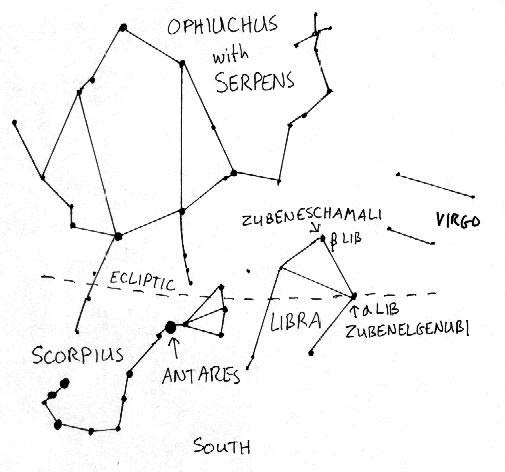Shortly after sunset, look low in the south for a group of stars shaped like a fishhook or the letter J. If you are far north, or don't have clear view of the south horizon, you may not be able to see the entire hook, just a fan shape at the top. But if you can see the entire constellation, notice that Scorpius is one of the rare constellations that actually looks like the thing it is supposed to represent - a scorpion. (And yes, the official name of the constellation is Scorpius, not Scorpio.)
Supposedly, Gaia (Mother Earth) grew annoyed at the great hunter Orion when he bragged that he had killed every animal on earth. How does a girl teach a lesson to a guy like that? Just set a little scorpion in his path and let it bring the brute down by attacking his foot.
The heart of the scorpion, at the base of the fan, is bright Antares. The Greek name for Mars is Ares, and this star was named "Rival of Mars" because of its reddish color. Antares is a red supergiant, and supergiant doesn't even come close to describing it. If Antares were located where our Sun is, it would extend past Mercury, Venus, Earth, and Mars, to approximately the orbit of Jupiter. Or put another way, if our Sun were a grapefruit in the middle of a football field (Earth would be a grain of salt on the 40 yard line), Antares would reach from goalpost to goalpost.

In between Scorpius and Virgo are two stars that look like the could have extended from the fan- shaped body of Scorpius. These stars are part of Libra, the Scales, and they were indeed once considered the claws the scorpion. The stars still bear their magnificent Arabic names - Zubeneschamali, meaning northern claw, and Zubenelgenubi for the southern claw. The Romans cut off the claws and created this constellation to demonstrate how important justice was to them. (Discuss amongst yourselves.) In some drawings, Virgo is shown holding the scales.
One of the oddities of, or some would say "problems with," the astrological zodiac, is that it doesn't correspond very neatly with what is actually going on in the sky. The ecliptic just barely passes through the top of the fan shape in Scorpius. The sun, moon, and planets spend a great deal more time mingling with the stars of the constellation directly above Scorpius, Ophiuchus (oh-fee-YOU-cuss).
This medicine man's feet stand over the Scorpion. According to legend, he was able to revive Orion after he was stung, and then set Orion and his little nemesis in opposite parts of the sky to prevent any further trouble. Ophiuchus holds a large snake. That constellation, Serpens, is the only one which is broken into two parts in the sky.
Ancient astrologers probably claimed this region for Scorpio because it was the brighter constellation. Still, it annoys modern astronomers who consider it just one of many problems with astrology. (Another problem is that, because the earth wobbles, the constellations and the dates assigned to them no longer line up.) If you are a Scorpio born in November, and either scientific or a troublemaker, feel free to tell people your sign is Ophiuchus.
July Moon Watch: The Moon reached first quarter on Sunday, when it looked like the right half of a circle. Why is it called "quarter" when it looks like a "half?" The quarter refers not to the shape of the visible Moon, but to the amount of time that has passed in the 28-day cycle.
The phase between the quarter Moon and the full Moon is called gibbous. The visible area is still growing larger, so this week is the waxing gibbous Moon. Each night, the moon will be further east at sunset. On July 10, it will be near Antares in Scorpius. As the moon grows brighter, its light washes out some of the fainter objects in the night sky.
The moon will also be visible every afternoon. This is a fine time to look at the moon through binoculars. At night, looking at a bright moon through binoculars or a telescope can overwhelm your eyes. In the late afternoon, though, you can see detail on the Moon without ruining you vision.
The moon will be full on Sunday, July 13, when it rises at sunset and sets at sunrise. Let your artistic side enjoy the large moon low on the horizon, but remind your scientific mind to measure it (using a finger or marks on a piece of paper) and see that it is the same size no matter where it is in the sky.

The Piker Press moderates all comments.
Click here for the commenting policy.